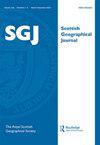Periglacial landforms of Dartmoor: an automated mapping approach to characterizing cold climate geomorphology
IF 2
4区 社会学
Q2 GEOGRAPHY
引用次数: 1
Abstract
ABSTRACT A systematic mapping approach characterizes Dartmoor periglacial landform signatures using the geomorphology of nine summit areas displaying well developed tor and blockfield landforms. This combines manual vectorisation with automatic classification and surface boulder identification, using spectral signatures to reveal patterns and distribution. Tors were classified using a three-fold scheme: T0 - summits with no tors; T1 - summits with castellated and high relief tors; T2 - summits with subdued or low relief tors. Clitter (blockfield and blockstream) features identified by automated mapping include boulder lobes and stripes and boulder-fronted lobes and terraces, arranged according to distance downslope from parent tors. This zonation of periglacial landforms is proposed as a landsystem signature for areas exposed to periglacial and permafrost processes for significant time during the Quaternary. It represents a process-form regime in which cold climate processes, acting on partially deeply weathered and pneumatolysised granite, produce castellated tors, cryoplanation benches and autochthonous blockfield (clitter), and permafrost creep develops boulder lobes that elongate and evolve downslope as allochthonous blockslopes with boulder stripes and boulder-fronted lobes and terraces. This demonstrates that automated mapping can be applied to areas of upland periglacial landforms to rapidly and systematically compile quantifiable patterns of landform assemblages.达特穆尔冰川周围地貌:表征寒冷气候地貌的自动制图方法
摘要:一种系统的测绘方法利用九个峰顶地区的地貌特征来表征达特穆尔冰川边缘地貌特征,这些峰顶地区显示出发育良好的tor和blockfield地貌。这将手动矢量化与自动分类和地表巨砾识别相结合,使用光谱特征来揭示模式和分布。Tors使用三重方案进行分类:T0-没有Tors的峰会;T1-带有槽型和高浮雕的顶部;T2-具有柔和或低起伏的顶点。通过自动测绘确定的碎屑岩(块体田和块体流)特征包括漂石裂片和条纹以及漂石前缘的裂片和阶地,根据与母岩的下坡距离排列。这种冰缘地貌的分带被认为是第四纪时期暴露于冰缘和永久冻土过程的地区的一种景观系统特征。它代表了一种过程形式,在这种过程中,寒冷的气候过程作用于部分深风化和气成花岗岩上,产生了城堡状隆起物、冻土台和本地块体场(斜坡),而永久冻土蠕变形成了巨石瓣,这些巨石瓣延长并向下演变为具有巨石条纹、巨石前缘瓣和阶地的异地块体斜坡。这表明,自动化测绘可以应用于冰川边缘高地地貌区域,以快速、系统地汇编可量化的地貌组合模式。
本文章由计算机程序翻译,如有差异,请以英文原文为准。
求助全文
约1分钟内获得全文
求助全文
来源期刊

Scottish Geographical Journal
GEOGRAPHY-
CiteScore
1.80
自引率
20.00%
发文量
19
期刊介绍:
The Scottish Geographical Journal is the learned publication of the Royal Scottish Geographical Society and is a continuation of the Scottish Geographical Magazine, first published in 1885. The Journal was relaunched in its present format in 1999. The Journal is international in outlook and publishes scholarly articles of original research from any branch of geography and on any part of the world, while at the same time maintaining a distinctive interest in and concern with issues relating to Scotland. “The Scottish Geographical Journal mixes physical and human geography in a way that no other international journal does. It deploys a long heritage of geography in Scotland to address the most pressing issues of today."
 求助内容:
求助内容: 应助结果提醒方式:
应助结果提醒方式:


